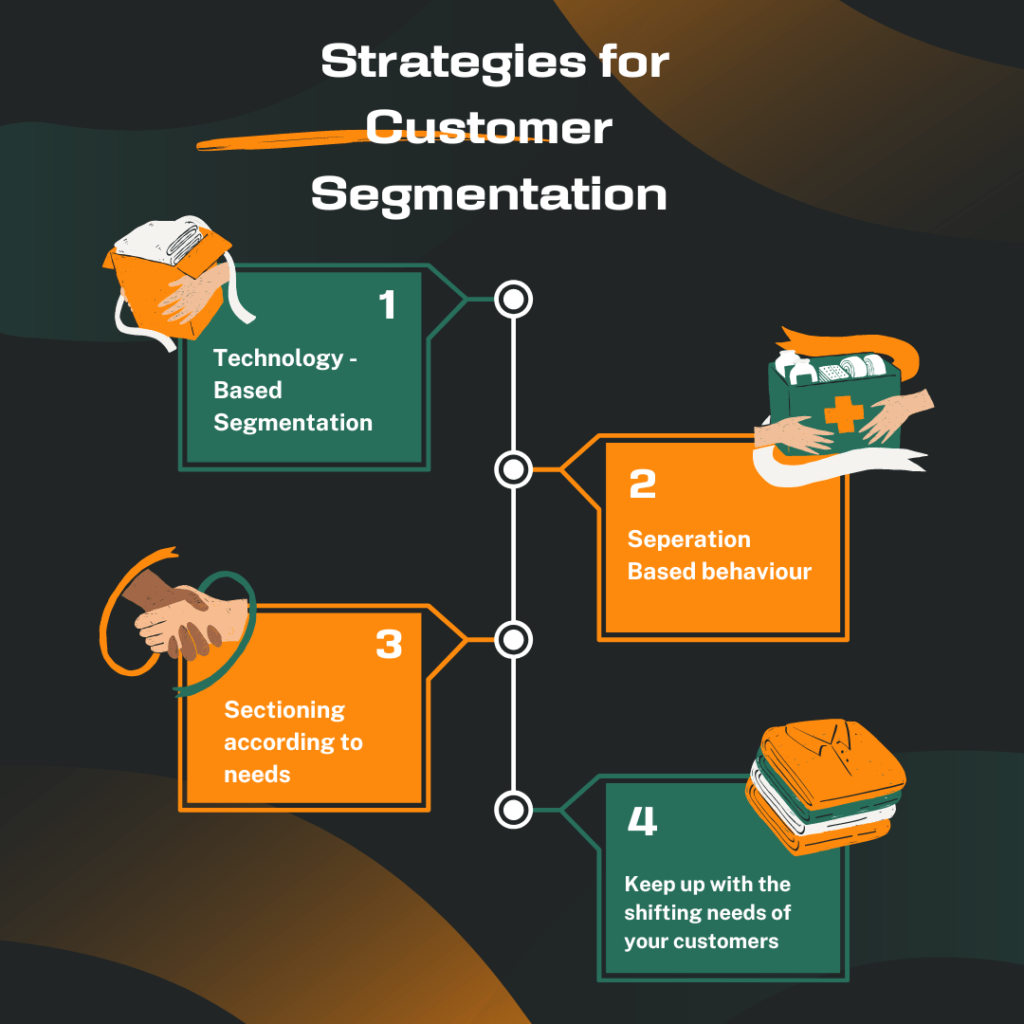The process of breaking down an uneven customer base into more similar groups according to specific features, needs, or behaviours is known as customer segmentation. This makes it possible for businesses to comprehend their clients more thoroughly and customize their marketing strategies to each group’s unique requirements and preferences.
Importance of Customer segmentation
Creating and sharing customized messages about products to specific groups of people
Customized marketing communications promote stronger bonds with your customers. This is because certain client groups will find a connection with these messages more than others. One segment requires a different approach to product or service communication than another.
For example, senior engineers in one of your customer segments might find it easier to understand technical information in infographics or white papers. Regular project managers might react better to less technical information conveyed through blogs or videos. Hence, using the most appropriate communication channels and customer segmentation enables you to customize your messaging to the unique demands of various segments.
Provides Better Customer Support
Providing better Customer support is crucial; it helps to know the needs and expectations of the client. Knowing which group needs extra attention makes it even easier to offer face-to-face interaction or telephone communications with customers where possible. This kind of data assists you in providing personalized customer service based on the unique requirements of every group.
To recognize and satisfy the wants and needs of your target market
The critical part of customer segmentation is understanding the needs and preferences of your targeted audience and providing the services they need. By knowing the needs and preferences of those who are your target audience, you can customize your offerings to fit their unique needs and requirements, increasing customer satisfaction and loyalty. You can improve your audience’s overall experience and propel business success by offering goods and services that meet their needs.
How are targeting and positioning affected by customer segmentation?
One effective marketing tactic that can significantly impact a business’s positioning and targeting is customer segmentation. Businesses can better position their goods and services to match the particular requirements of each segment and launch more focused marketing campaigns by breaking up their client base into smaller, more concentrated groups based on shared traits. The process of figuring out which particular customer segments a company wishes to reach with its marketing campaigns is known as targeting.
The various kinds of strategies for customer segmentation

Technology-Based Segmentation
Technology-based segmentation is essential for businesses to target their audiences successfully in the current digital era. By utilizing data analytics and machine learning algorithms, companies might divide their clientele based on online Behaviour, device preferences, and interaction patterns. They can improve customer experiences, optimize product offerings, and develop tailored marketing campaigns. Technology-driven segmentation enables businesses to maintain an advantage in the competitive landscape by providing relevant information and solutions to their target market segments.
Separation based on Behaviour
Customer segmentation is based on Behaviour and involves grouping customers according to their actions, interactions, behaviours, and level of engagement with goods and services. This method puts more excellent value on understanding customer behaviour than it does on their demographic or psychographic features. Through a closer look at variables like past purchases, frequency of purchases, browsing habits, reaction to marketing campaigns, and brand loyalty, Companies can recognize various customer segments that share comparable behavioral characteristics.
Sectioning according to needs
Customers are grouped based on their unique needs, preferences, and obstacles when you segment your customer base based on needs. With this strategy, companies can better customize their product offerings and marketing campaigns to each segment’s needs. Businesses can improve customer satisfaction, build stronger relationships, and eventually spur growth and profitability by understanding and satisfying these varied needs.
Keep up with the shifting needs of your customers
Take the time to learn about your customer’s priorities by listening to them and posing pertinent questions. Allow them to dictate the speed. Learn about their decision-making process, mindset, and needs, both present and future. When necessary, move quickly, but above all, show responsiveness.
Methods for defining and identifying customer segments
Businesses use various techniques to define and identify customer segments for segmentation. First, they gather information on their customers’ demographics, habits, and preferences through thorough market research. Using sophisticated analytics techniques like clustering and regression analysis, they then examine this data to find trends and commonalities among the clients. Businesses can create discrete customer segments based on these insights, which are then tested and refined through iteration and refinement to guarantee accuracy and efficacy in addressing particular audiences.
The advantages of segmenting your customer base.
A better comprehension of clients
Among the primary advantages of client segmentation is a deeper understanding of customers. Businesses can obtain more profound insights into various customer groups’ needs, preferences, and purchasing patterns by breaking down a diverse customer base into more manageable, smaller groups according to shared traits or behaviors. Businesses can better meet the unique needs of each segment by customizing their marketing strategies, offerings, and services thanks to this improved understanding, which eventually results in more successful and focused marketing campaigns, happier customers, and higher retention rates.
Enhanced Loyalty of Customers
One significant benefit of customer segmentation is increased customer loyalty. Companies can more effectively fulfill the demands of their various customer segments by customizing their offerings and communication strategies based on understanding their distinct needs and preferences. Customers feel more connected to this personalized approach, which boosts customer satisfaction and loyalty. When a brand regularly provides relevant and individualized encounters, clients are more inclined to stay with it, which boosts retention rates and increases customer lifetime value.
Enhanced Profitability
Enhanced financial gain is among the principal advantages of customer segmentation. Businesses can better target their marketing efforts, products, and services to each segment’s unique needs and preferences by segmenting their customer base based on shared traits or behaviours. With a targeted approach, businesses can focus on high-value segments that yield the highest revenue and profit, allowing for more efficient resource allocation. Furthermore, by using customer segmentation, companies can find ways to upsell or cross-sell to current clients, raising average transaction values and overall profitability.
Enhanced advertising
Enhancing advertisement is the most significant advantage for customer segmentation, as it shares extra information about the products and services with the customer. Additionally, since campaigns are more precisely targeted to people most likely to be interested in the goods or services being promoted, enhanced advertising through segmentation can result in higher conversion rates and returns on investment. In general, customer segmentation increases advertising efficiency by enabling companies to communicate and engage their intended audience more tailored and captivatingly.
Conclusion
In conclusion, companies looking to get the most out of their marketing initiatives and succeed in today’s competitive business world must employ effective customer segmentation and targeting techniques. By utilizing essential methods like psychographic, behavioral, geographic, and demographic segmentation, companies can better understand their clientele and customize their advertising approaches to suit various groups’ distinct requirements and inclinations. Companies can improve customer satisfaction, boost brand loyalty, and increase revenue and profitability by implementing targeted messaging, personalized experiences, and efficient resource allocation. Ultimately, companies can position themselves for long-term growth and success in the dynamic marketplace by perfecting the art of customer segmentation and targeting.
FAQ’s
What distinguishes customer segmentation from customer targeting?
Targeting is concentrating your marketing efforts on a particular demographic you believe will most likely purchase your goods or services. Dividing your market into groups according to attributes such as age, gender, income bracket, etc., is known as segmentation.
What does the term “customer segmentation” mean?
To provide more relevant experiences, customer segmentation involves grouping customers into distinct groups according to shared traits, actions, or preferences.
What is the segmentation of customers’ processes?
Businesses use the technique of customer segmentation to separate their clients into groups based on shared traits or habits. Companies can improve product offerings, boost customer satisfaction, more fully comprehend the requirements and inclinations of their audience, and tailor marketing strategies thanks to this segmentation.
What are the three stages of segmentation?
The segmentation process has three stages:
Which three categories of customers are there?
The following three client categories are:

